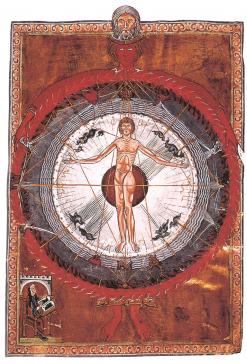Hildegard of Bingen (1098–1179) was a prophet and a unique intellectual. Hildegard wrote that her visionary experiences were the sole source for the vast body of knowledge loaded into her visionary books. Her visionary experience began with a visual phase and continued with an audial phase. The voices in the audial phase explained the images of the visual phase, revealing deep abstract insights. Consequently, Hildegard’s books are a collection of abstract ideas anchored in concrete visual forms.
In her visionary books, Hildegard discussed anthropological issues and issues from the science of body and soul. In these discussions, Hildegard related also to ordinary senses. Therefore, Hildegard had two distinct modes of sensory perception: first, a visionary mode, by which she gained her theological insights; second, an ordinary mode, for the perceptions of ordinary life. I seek to understand the connection between the two modes according to Hildegard.
During my visit to MPIWG I plan to work on Hildegard's last book, Liber Divinorum operum. A manuscript of this book (Lucca MS) contains illustrations of the visions. This manuscript is dated to the first half of the thirteenth century, about fifty years after Hildegard died. I will try to understand from the illustrations how Hildegard was thought of after her death, as a prophet who had also written on premodern scientific questions. The illustrations are influenced by scientific diagrams. At the same time, they depict Hildegard experiencing her visions. My project seeks to understand how these two lines, scientific and mystic, co-occur.

